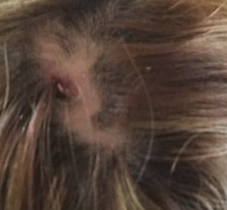The first photo set is a woman who had her hairline lowered the day before these pictures was taken. Please note that the washing was so complete and the recipient sites so samll, that the recipient sites could barely be seen so I labeled the frontal view where a faint outline of the recipient sites show up. The hairline was extensively lowered which is the case when we often perform this hairline lowering for traction alopecia in the African American population. From the side view, there is almost nothing to see. Careful, small site recipient areas are critical to an undetectable transplant. For those who understand how difficult the African hair type is for a hair transplant (very kinky), the viewer should understand how beautiful these one day post-operative photos are.
The second woman is also one day after her surgery with a smaller distance for the hairline lowering surgery than the above patient. This was performed with an extensive restoration of her temple corners. Many women lose their temple corners as they get older and a rounded frontal hairline (which is a typical female hairline) is critical to achieving a very feminine look for many women, unlike men, on the other hand, who have high corner, V-shaped hairlines.





